Biden Lied to Land the Economy
Help: I have Biden Infatuation Syndrome
Biden has had a terrible couple weeks. I generally think it’s in poor taste to dunk on an old man on twitter for getting cancer. But everybody who’s been doing exactly that has their reasons. And I have to admit, aggressive stage 4 prostate cancer doesn’t just appear out of the blue. It’s likely he’s been aware of it for some time now.
And then there are the other aspects of his health. It seems that his team was covering up his severely diminished cognitive fitness, too. You know all about that though. Let’s get to the point.
In this time of great criticism of the Biden family and administration, I think the natural response is to praise them to the heavens.
This isn’t a joke. I’m writing this because I am a contrarian during COVID, Biden snatched Biden’s admin snatched a victory from the jaws of economic defeat, a feat that the Canadians, Europeans, Chinese, Japanese and hell, almost everywhere you look in the first half of this decade, could not accomplish.
And, it was primarily through his genius policy of letting in unprecedented numbers of illegal immigrants, which I view as one of the best things a president has done in my lifetime.
Rightoid: “Alright, enough doodling with words. I’m skeptical. How can you say Biden letting in all those cartel-affiliated, norm-violating, child-killing, cat-eating, fentanyl ferrying, looking and talking slightly different from the humans I grew up around which I find frightening because of out-group bias but rationalize after the fact as not liking because they are sourced from nations still developing, (inhales sharply) and most importantly, low-skill job stealing, (another breath) immigrants! Illegal immigrants at that. So you must be joking when you say it was a genius policy. C’mon man, show me the data.”
Bet.
U.S.A. VS The World
First of all, let’s dispel any pro-European myths, so we can get on the same economic footing. There has been, since the financial crisis, perhaps not a great divergence, but at least a moderate one. I’ll let the graph speak for itself.
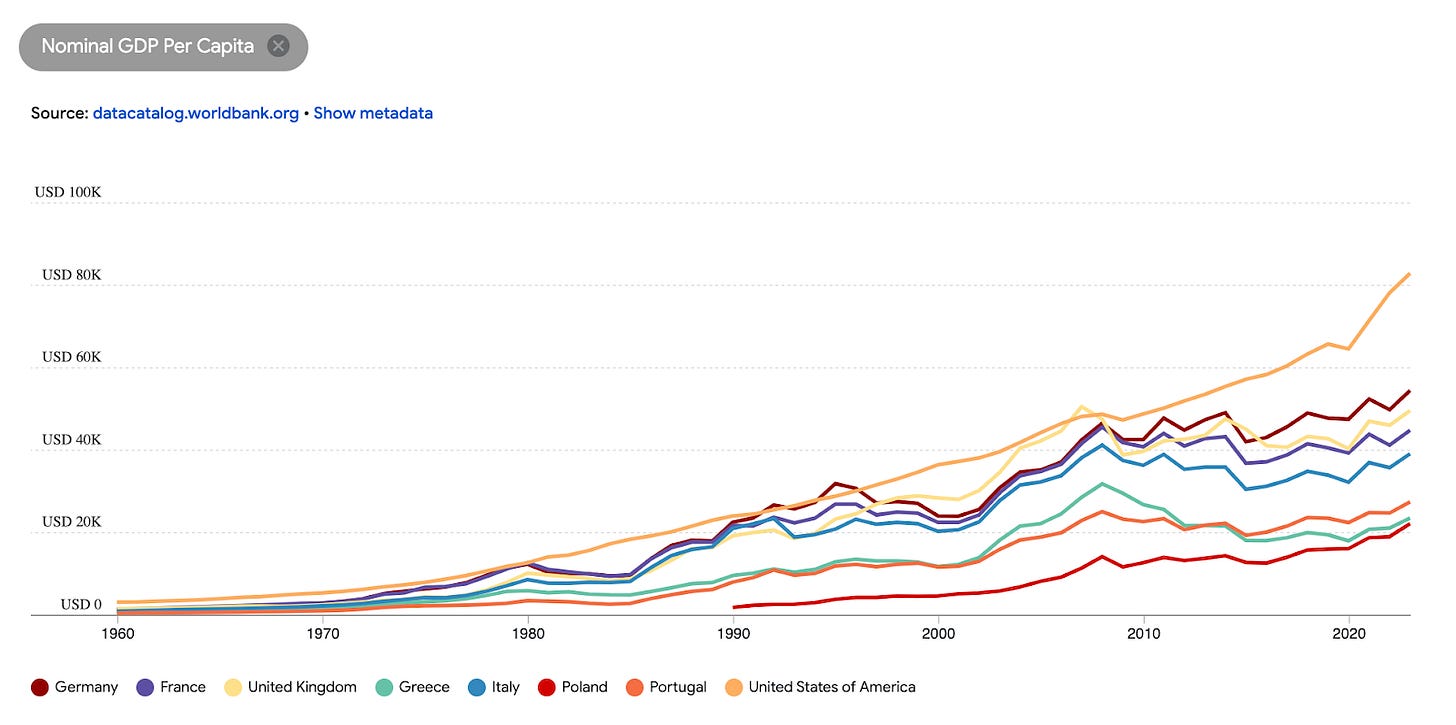
In 2007, the UK, Germany, and the U.S. were all about equal, with an interval of 42,000 - 50,000. Of course the Mediterranean countries were lagging, but not as much as today. Today, France and Italy are about half of the U.S.’s GDP per capita. The UK and Germany are at 50,000 and 54,000 respectively. The U.S? 83,000. The U.S. has done extremely well!
Lefty: “Jesus Christ. As if GDP matters. Everybody knows Europe’s way better because it’s more equal. Jeff Bezos and Elon Musk have the lion’s share of that extra wealth. And also, you get free college, and free healthcare! I’m getting off track, the point is that you’re just another neo-liberal asshole who only cares about GDP, which is completely irrelevant because it’s an average, not a median, and also doesn’t take into account how Europeans are still just as rich in other ways.”
Okie dokie.
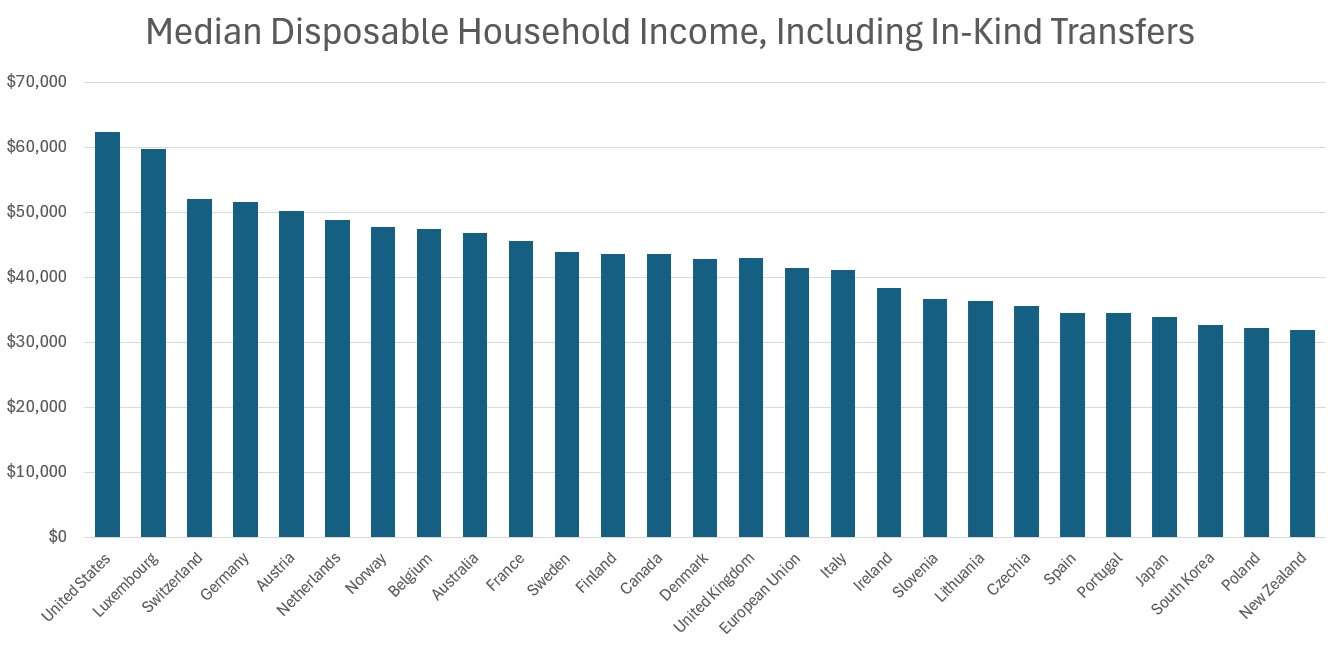
Median, plus in-kind transfers, which include free college, healthcare…
Anyway, sure, Europe is still a nice place to live, (and Canada too), and GDP, or even disposable income, does not capture every single facet of “the good life”. But income is still incredibly important. And any sober analysis should conclude that a significant economic gap has emerged, which didn’t exist in the past.
Degrowth is not good. It lowers your economic opportunity, your income, the variety of goods available to you, the rate at which new technologies become available to you, and many more things.
Soft Landing
Okay. We’re standing on similar economic ground now. Let’s talk about more recent history. You’ll notice if you scroll back up to that first graph, that, although the U.S. was already pulling away after 2007, post-2020, the U.S. was shifted to a different gear post 2021. Why was that?
Let’s look at where the U.S. was by the end of Biden’s term, and then I’ll explain how we got there.
Noah Smith concisely summarizes what you want from a macroeconomy:
You want high employment rates, so that everyone who wants a job has a job.
You want low and stable inflation rates, so that people know how much a dollar will be worth a month from now.
You want fast wage growth, so that regular working people are taking home their share of economic growth.
And you want fast productivity growth, because ultimately that’s what creates durable gains in living standards.
By the end of Biden’s term, the U.S. had all 4.
Okay, now let’s get comparative again. These statistics are obviously amazing, and we’ll get into how the Biden admin was able to pull them off when he entered office during a recession, (!) but first let’s look at how impressive these stats are when you think about how almost every other country failed to accomplish what the Biden admin did under the same circumstances. (the pandemic was global after all)
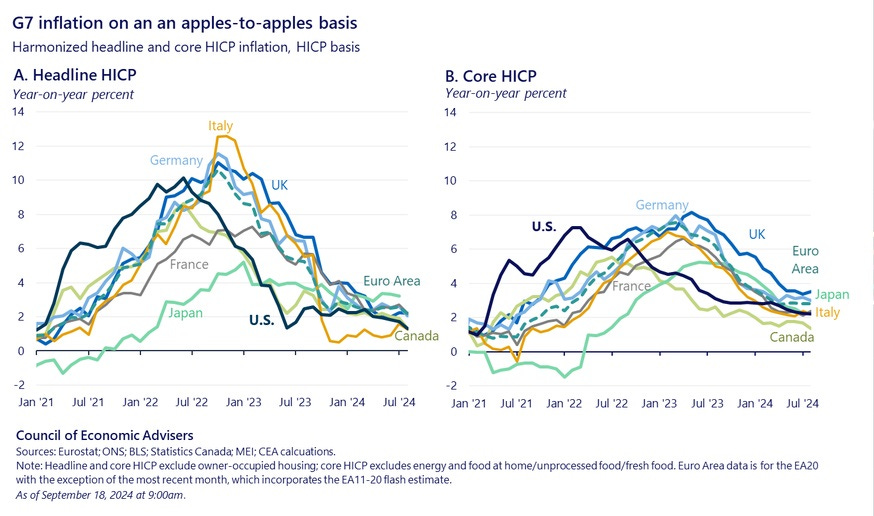
Isn’t it remarkable how the U.S. was able to have a red hot growing economy while having low inflation?? I wonder what could have caused this…
Okay, let’s get to the meat of the article. Colourful graphs are fun, but you want to know, how was this possible? How much credit does Biden deserve? I’ll give you the economics, and let you decide.
The year is 2020. Trump is still in office. The economy is plunged into sharp, negative demand shock. (reduced economic activity due to closures) Plus a sharp negative supply shock! (disruptions to supply chains, agriculture, manufacturing) Recession ensues. Scroll back up to see the effects.
Policy response: You’re Joe Biden. How do you react? Like a good Keynesian you roll out fiscal stimulus. (direct payments, business loans, government jobs) You also use monetary policy (Biden re-appointed Powell, so he gets some credit) to spur investment. That all boosts aggregate demand. This is by-the-book thinking. But what about supply?
The legal immigration system is much to cumbersome to rapidly reform in a time of crisis. And it’s incredibly hard to immigrate to America legally:
So, Biden goes for the long ball: let in unprecedented amounts of illegal immigrants in order to fix supply side issues. More specifically: Induce record net immigration through expedition and humanitarian channels.
Now, sectors that were struggling with labour shortages are running hot. Biden has now counterbalanced both supply and demand side shocks.
But then the usual problem occurs with by the book, Keynesian demand side stimulus. The economy gets too hot, and inflation rises. It’s good that consumer spending is up, but it starts to feel like wack em’ all with new problems being created by your solutions.
So, in almost all countries, prices rose. This was more or less inevitable, the real question was: how long will inflation last?
In the above graph, you saw the U.S.’s inflation rate fell below others after 2022. But by mid-2022, it was sitting at 8 percent.
So the Fed acted quickly by raising interest rates. Higher interest rates mean saving is more lucrative, so more saving and less consumption, so less economic activity, so less inflation!
Wait a minute. Higher rates → lower investment and consumption → lower GDP → higher unemployment. Shit. This is the quintessential problem for clawing your way out of a recession. How much is too much, or too little? How do we get that Goldilocks zone?
How did Biden stick the soft landing, when almost no other country could?
Answer: A very large, very sudden immigration shock. Net immigration jumps to 2.6 million in 2022 and 3.3 million in 2023, triple what the Congressional Budget Office had assumed pre-pandemic.
So immigrants are solving your supply side problems. Your labour shortages and your supply chain inefficiencies. And the immigrants are also keeping employment high. And the immigrants are also buying groceries, shoes, Spotify subscriptions, maybe.
All that consumption is solving your demand side problems. So now, you can keep interest rates high, which causes inflation to go down, while still keeping the economy humming along. More workers raised your output, so 5 %+ rates were restrictive relative to the old baseline, but roughly neutral to the new one.
And all because we simply let people work for who they want to work for, and let employers employ who they want to employ. Or… gave people the economic freedom to do what they want to do. It shouldn’t be surprising that economic freedom is better for everybody…
So, to summarize: Supply and demand expand together, headline consumer price index falls to around 2% by the end of Biden’s term, while real GDP still grew ~2 %.
A textbook soft landing.
Did the immigrants respond to labour market tightness, or did they create the conditions for the soft landing? In my opinion, a bit of both. Either way, the Biden admin deserves, at the very least, a bit of recognition.
Look, I’m not going to glaze Biden that hard. If I’m being objective, the narrative isn’t that immigration was the only thing that mattered. Monetary timing, and a dose of luck were present. Jerome Powell deserves flowers. While border and immigration policies are set by the administration, the scale and nature of migration flows are influenced by many factors beyond a simple "letting in" policy. But, the Biden administration desired and successfully executed on a few key measures to increase immigration at the right time, such as through expedition and loosening humanitarian channels of entry. And of course, the Biden admin is never going to come out and say “we’re trying to dramatically increase illegal immigration, but don’t worry, it’s good for you.” Perhaps the smarter play is to silently loosen things up. Of course this is speculation. But hopefully this has all raised your probability on the Biden admin’s increased immigration being highly likely to be the swing factor in this story. One that lets the Fed squeeze inflation mid-way through his term without kneecapping employment.
The product of this success story?
And before you say those immigrants caused more crime…
The reason for this? Because as much as conservative media liked to harp on anecdotes, real data confirms that immigrants, even illegal immigrants, commit less crime on average then natives.
I’m not sure about Europe. Perhaps it’s different. But at least in the U.S., if you let in more immigrants into the pool of possible criminals, illegal or otherwise, you should actually expect to reduce your average crime rate, not increase it.
It doesn’t take much effort to see why. As said earlier, legal immigration is incredibly hard. So many, if they don’t have a relative, simply illegally immigrate. This isn’t surprising. Would you cross a river illegally if it meant you could escape a lifetime of poverty? And let me ask another question. After making this journey, would you then decide to squander it? Who has more to lose, a citizen or an illegal immigrant? In general, people who take one big risk need not be pro-risk universally. Immigrants are often risk-averse in other dimensions.
Something might be troubling you. “Cool story, nice graphs. But if it’s so interesting, and worked so well, how come Economists aren’t talking about it?”
Nice trick question. Economists are talking about it! The Federal Reserve Bank of Dallas: “Higher immigration probably added 70-100 k jobs a month in 2022-24 and trimmed core inflation by ~0.2 ppt.” Jason Furman, a Harvard Economist: “Immigration has been the swing factor keeping wage growth contained despite low unemployment.” The IMF: “The surprise labor-supply boom explains why the U.S. out-performed the Eurozone on both growth and disinflation.” Goldman Sachs: “Markets are pricing a soft landing largely because of the labor-force math.”
People are talking about it, just not on cable news, for very obvious culture war and attention span issues.
Looking ahead
Trump is pledging to cut immigration by the millions, and revive mass deportations. Following the causal reasoning from above, but backwards: Lower labour supply, higher wages, higher prices, especially in immigrant-intensive industries, like agriculture, the hotel industry, and construction, among others. Powell is thinking likewise: “Fed staff already warn that deportations would “detract from the growing supply of labor … creating wage and price pressures.”
Of course, we might be seeing an output hit too. Reduced GDP growth is hopefully something I don’t have to explain is terrible. But at the very least, those 5% Fed Funds rate suddenly is restrictive again, raising recession odds.
So, what’s the conclusion here?
The Biden strategy wasn’t crazy socialist power grab or a hollowing out of the American working class or an attempt to get more Democratic voters (which didn’t even work anyway), it was simple, sophisticated Econ 101: raise supply when you raise demand. Deport that new supply, and expect the mirror image: higher prices, lower growth, tighter labour markets, and, yes, higher average crime.







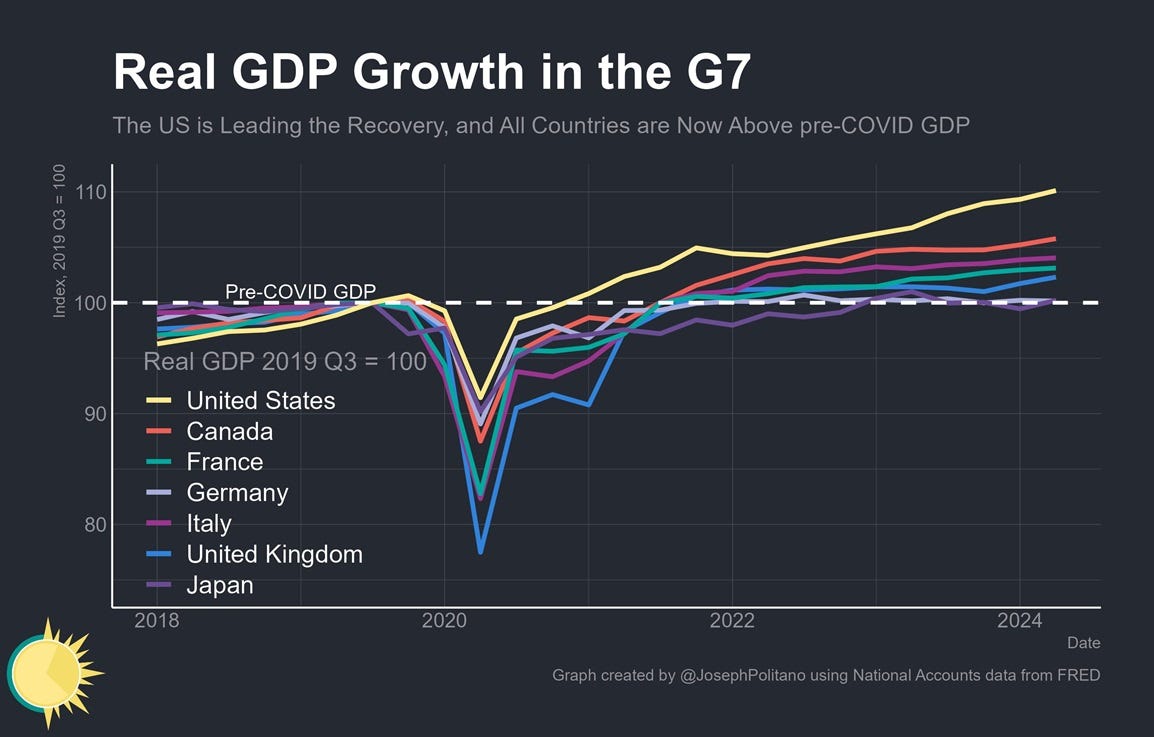
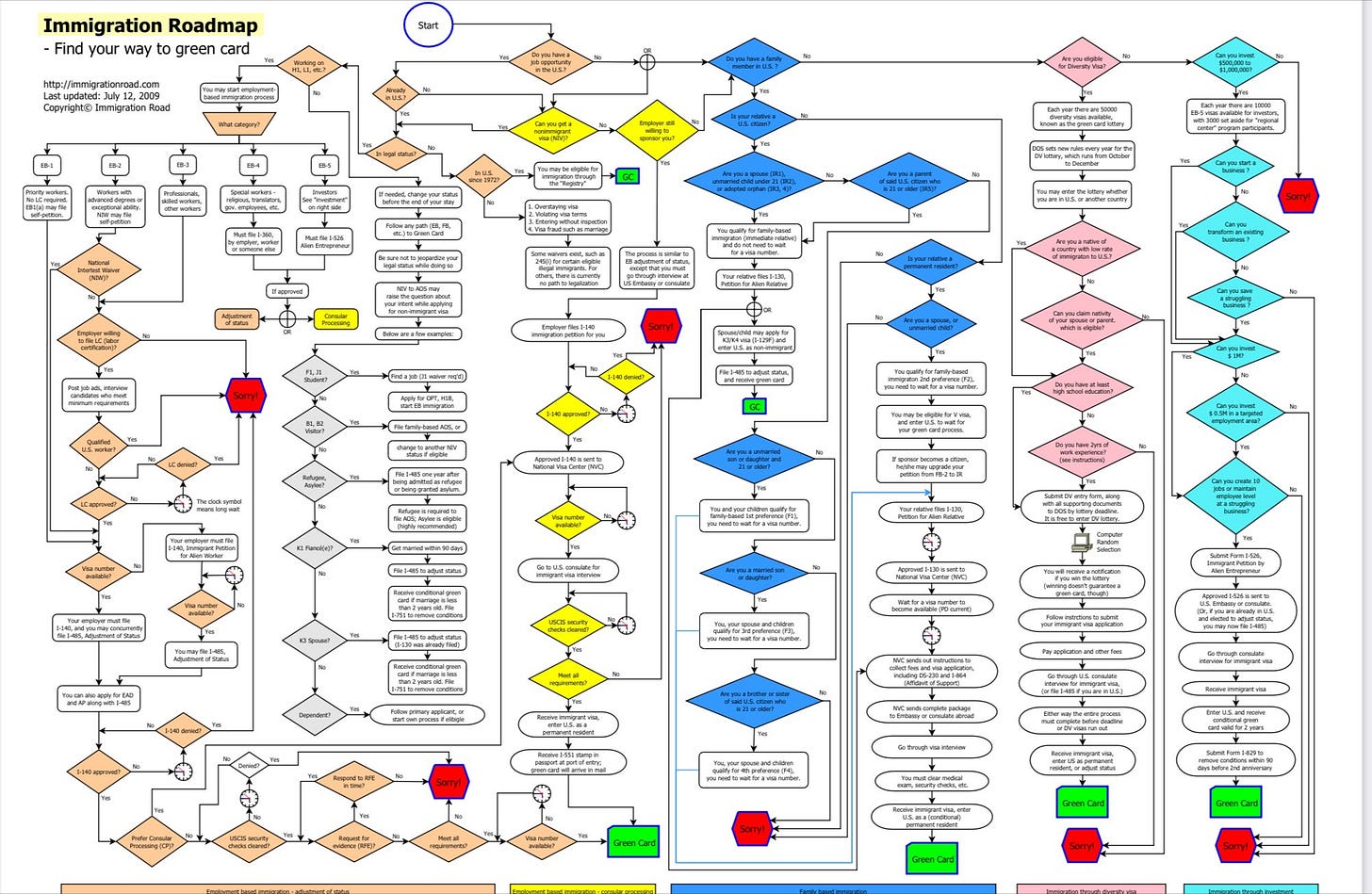






I like this article, it's very interesting and takes a unique perspective. You've convinced me of the premises of your argument but I want to disagree with your conclusion. I would not congratulate Biden for saving the economy in this manner. I believe it's an incredibly short sighted approach which works to the detriment of country long term. Why? Because this essentially a temporary fix, a temporary fix ontop of a thousand temporary fixes. Putting aside cultural arguments which I do find relevant to this issue, assuming they were all allowed to stay and the economy adjusts, the average American is much poorer in real terms. And this effect already began to take shape prior to the election which I think is the number one reason Trump won. The economy should have been allowed to crash, we are still producing a bunch of stuff no one demands, I believe Trump just might cause that crash despite it being the opposite of what he wants. Regardless this article really made me think so thank you.
Nicely reasoned. I have to let this soak in for a minute.